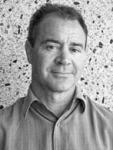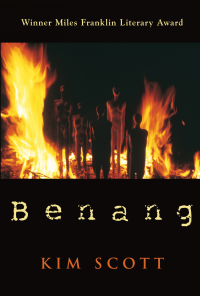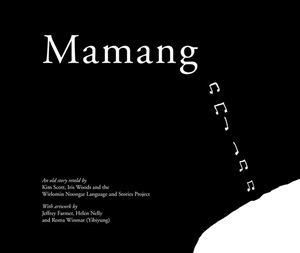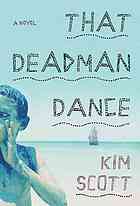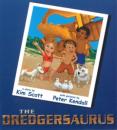AustLit
-
In the third of the series of interviews, Anita speaks to Kim Scott.
Kim Scott is a two-time winner of the Miles Franklin Award - the first ever Indigenous winner of that award - for his novels Benang: From the Heart and That Deadman Dance. He has a background in education and the arts and is proactive in Wirlomin Noongar Language reclamation in Western Australia.
-
I mostly like to say Wirlomin Noongar, partly to pay my respects and acknowledge a debt to Elders of the Roberts clan, particularly Hazel Brown, Lomas Roberts, and Audrey Brown. Very few carry my family name - my father being the only surviving child of a Noongar woman with the name of Coleman born at Ravensthorpe near the beginning of the twentieth century and who died young (as did my father). It’s primarily thanks to the above-named elders that any family connection and community memory of so-named people also known by a Noongar name anglicised to 'Winnery' remained in the south-west.
The usual map of language-groups also labels my ancestral community Wudjari, inhabiting a relatively thin strip of mostly coastal country from - to use the most popular place-names - east of Esperance to Gairdner River on the south coast of Western Australia, and with the town of Ravensthorpe near its centre. Ravensthorpe is a town often referred to as the centre of ‘taboo country’ because of the extent of killing there in the late nineteenth century. It’s also country divided between two Land Councils, the South West Aboriginal Land and Sea Council’s Wagyl Kaip, and the Goldfields Land Council’s Esperance Noongars. It thus has some competing labels, and claims as to authority and protocol.
I like to say I’m one among those who call themselves Noongar, and descended from those who first created human society on this portion of the oldest continent on the planet, because this implies collective privilege and responsibility.
Having prioritised all of the above, it’s also appropriate to acknowledge that I have a wide spread - if not the same depth - of non-Aboriginal family, and Irish-Scottish ancestry that also obviously contributes to what and who I am.
-
What were your favourite books growing up?
Difficult to say, and I don’t think there was a one. In my early teenage years, it was possibly Ian Fleming’s James Bond series, or any popular fiction that was a bit ‘racy’ and featured sex and fighting and money.
I remember with a surprising vividness some of the books at my primary school in the ‘Happy Venture’ series, including a story of nasturtiums flaming from a boot to set a house on fire. Perhaps most vividly, when I put my mind to it, I remember reading Mark Twain’s Tom Sawyer at a very young age, simply because I saw my father’s name in its first few lines and thought it must have been about his childhood. That was motivation enough for me to struggle and persist in reading it, and by the time I realised that it was about someone else altogether I was hooked by the story.
-
What book has had an impact on your life and why?
Well, Tom Sawyer, for the reasons above. Salman Rushdie’s Midnight’s Children meant a lot to me when I first read it, as did Gunter Grass’s The Tin Drum, and both showed me ways of dealing with history in fiction.
Sherman Alexie’s The Toughest Indian in the World inspired me at one time. Peter Carey's collection of short stories, The Fatman in History showed me how fiction could playfully open minds. Kevin Gilbert’s Living Black: Blacks talk to Kevin Gilbert startled me with its courage and honesty.
More recently, if I may shamelessly mention work with which I’ve been connected, the Wirlomin Noongar Language and Stories project has produced books featuring courageous, risk-taking protagonists and themes of transformation.
-
Last book I read was Quarantine, by Jim Crace. I enjoyed it.
-
-
Joseph Conrad’s Nostromo, Great Expectations by Charles Dickens. Kevin Gilbert’s Living Black. The Accidental Tourist, by Anne Tyler. Salman Rushdie, Midnight’s Children, The Remains of the Day by Kazuo Ishiguro, Elsewhere Perhaps, by Amos Oz, The Man from the Sunrise Side, by Ambrose Chalarimeri , Green Grass, Running Water by Tom King. And many others.
-
Having recently completed it I think The Biggest Estate on Earth by Bill Gammage is an important book. For Their Own Good, by Anna Haebich focuses on south-west Western Australia, but the power relationship it articulates applies across the continent.
Preferably, an anthology of writing from the[ir] own region in which they live along the lines of Those Who Remain Will Always Remember: an Anthology of Aboriginal Writing, edited by Rosemary van den Berg, Anne Brewster and Angeline O'Neill. The script of Jimmy Chi’s Bran Nue Dae (and listen to the music).
-
Did you do anything to help you learn to write or did it just come naturally?
Both. It came from having things to draw on, from having books around me, from admiration for people who were able to give stories and silence. I saw other people reading books. I was good at ‘English’ at school and ended up studying ‘literary theory’ at a time when respectful, liberating interpretation was encouraged, and I did indeed take courage from it. I was an English teacher, and understood that I needed to teach myself to write.
-
For me, Eduardo Galeano puts it very well in his essay ‘In Defence of the Word’. But it is also the momentary pleasures of complete absorption in a new story. The intimate relationship with a reader pleases me, as does the possibility of a collaborative shaping of magic and creation. I like it that the imagination and feelings of future friends in faraway places are stimulated by my marks on the page.
-
To reach and connect. To provoke, sometimes. To transform, if only a little. As Elizabeth Jolley said, to provide ‘places where people may meet’.
To touch on greater truths. Language and stories shape the world; I sometimes want to flex and remake it again. I write for an imagined, ideal reader; someone a little like myself, but much better. Sometimes an idealized ancestor, or descendant.
-
Bravery. Honesty. Respect for the craft. Pleasure in language. Discipline. Playfulness. Kazuo Ishiguro for restraint and control. Eduardo Galeano for audacity and sincerity. Marie Munkara for the laughter. Gail Jones for a light touch. Anita Heiss for her positive spirit and contribution. Lionel Fogarty and Romaine Moreton (for their poetry) … and I guess also William Shakespeare, and W. H. Auden, and Robert Lowell and T. S. Eliot too. Melissa Lucashenko for her brave vulnerabilities, Alexis Wright for her wisdom and intensity … Alice Munro, Toni Morrison, Peter Carey, especially for making The Fatman in History available when I was a young man. Patrick White for the rigour and the slippery sensibility. Raymond Carver, Lorrie Moore and Joan London. My colleagues David Whish-Wilson and Julienne van Loon … I could continue listing names, but do not want them ranked by my recall. There’d be another list another day. Come to think of it I know a fine story by Octavio Paz, another by Dallas Wiebe … But 'the naming of cats is a difficult matter' (T. S. Eliot).
-
Not really. I recently saw the documentary Searching for Sugarman, and found its story of singer-songwriter Rodriguez so inspiring.
-
The Wirlomin Noongar Language and Story Project and attempting some short screenplays. Hoping I’ve begun another novel …
You might be interested in...


